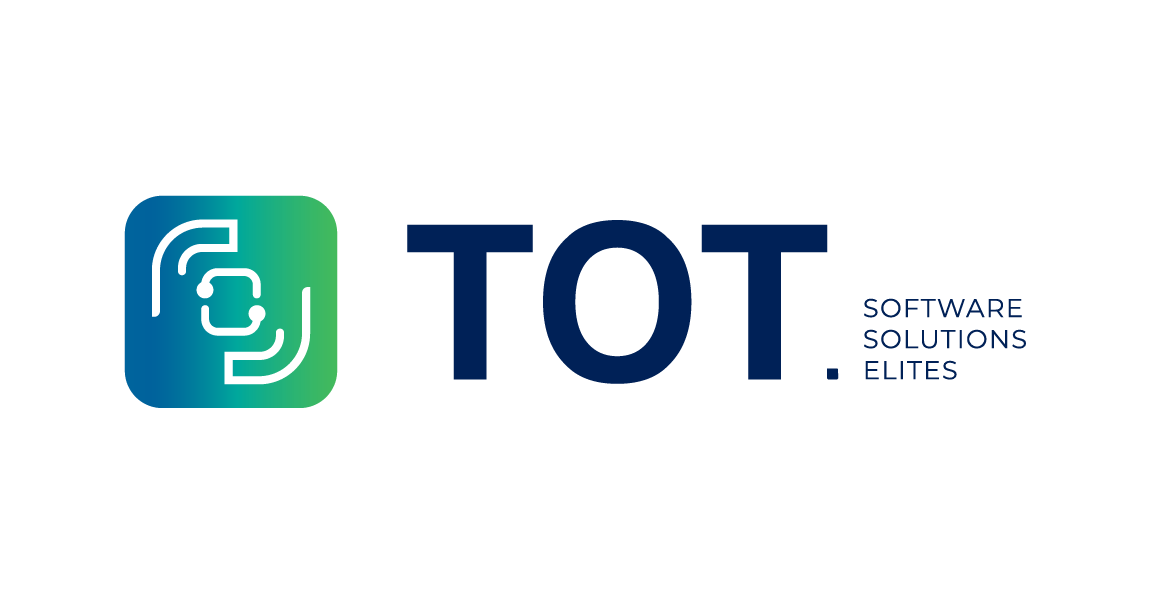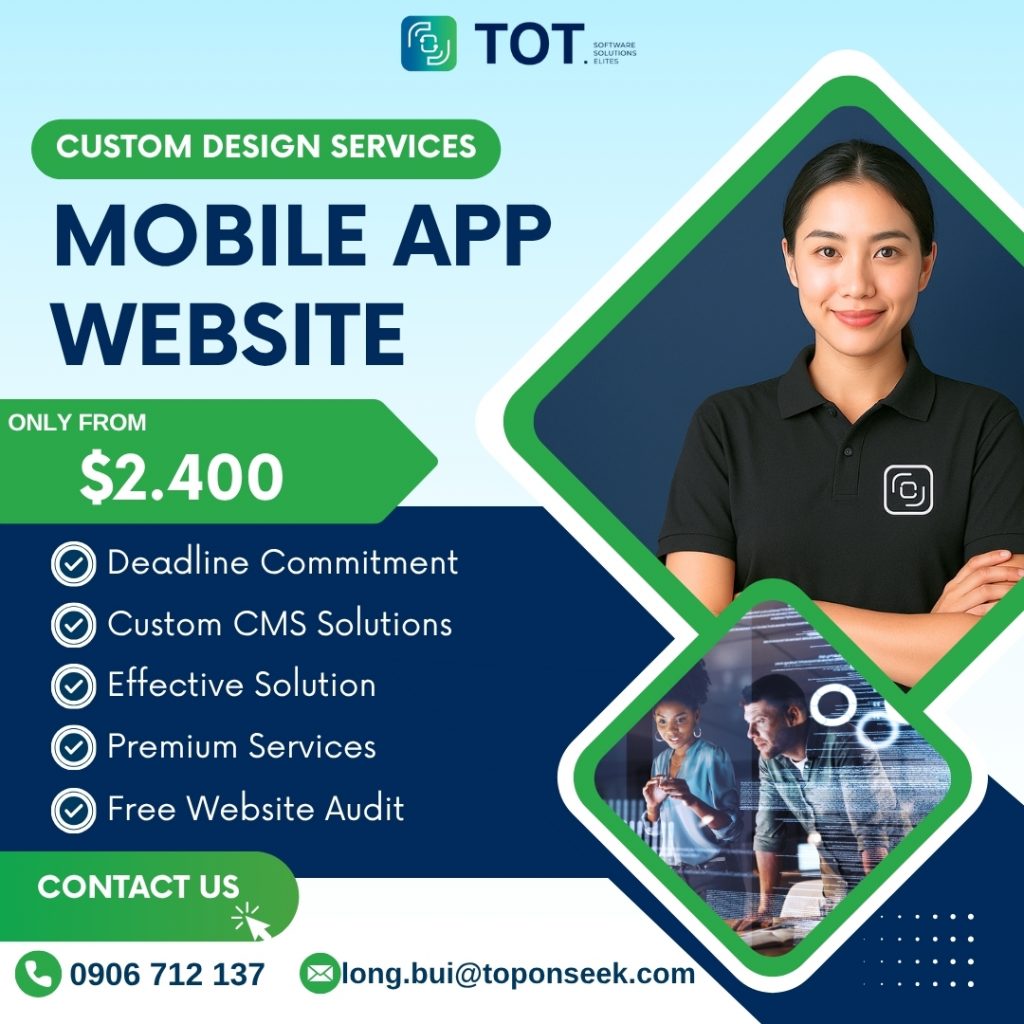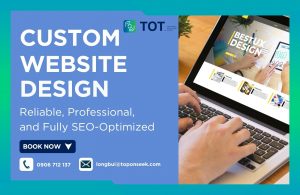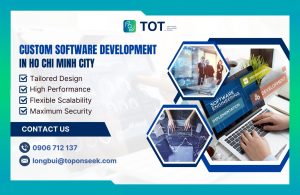Software development methodologies play a crucial role in guiding teams through the complex process of building software. Choosing the right approach can improve project efficiency, enhance product quality, and ensure timely delivery. In this article, TopOnTech explores 15 software development methodologies, highlights their benefits, and provides a clear comparison to help businesses and development teams select the most suitable approach for their projects.
>>> See more:
- Top 12 Web Design Agencies in Vietnam – Trusted & Professional
- Top 15 Software Outsourcing Company in Vietnam
- Top 10 Web Agency Offshore Companies for Global Businesses
- Top 15 Best Web Design Companies in Ho Chi Minh City (2025)
What is Software Development Methodology?
A software development methodology is a structured framework used to plan, manage, and execute software projects. It defines how teams collaborate, how requirements are gathered, code is produced, and software is tested and delivered. A methodology provides guidelines, processes, and best practices to ensure projects are completed efficiently, predictably, and with high quality. Choosing the right methods is crucial because it directly affects development speed, flexibility, product quality, and overall project success.
>> Read more: Top 10 IT Outsourcing Companies in Vietnam
Top 15 Software Development Methodologies
The world of software development offers a variety of methodologies, each designed to manage projects efficiently while meeting specific business and technical requirements. Understanding the strengths, limitations, and use cases of each methodology can help teams deliver high-quality software on time and within budget. In this section, we introduce the top 15 software development methodologies, providing insights into how they work, their benefits, and the types of projects they are best suited for.
1. Agile Software Development Methodology
Agile is one of the most widely adopted software development methodologies today, offering a flexible and user-focused alternative to traditional, linear workflows. Instead of prioritizing heavy documentation and strict processes, Agile centers on delivering real value to end users through continuous improvement. In this approach, projects are divided into short sprints – typically lasting 1 to 4 weeks – allowing teams to iterate quickly, test frequently, and adjust based on real-time feedback. As development progresses, customer input plays a critical role, ensuring that the product evolves in the right direction.
Strong communication is the foundation of Agile. It encourages close collaboration between developers, clients, and users, resulting in faster delivery, better product alignment, and more efficient problem-solving, which makes Agile a top choice for modern software development teams.
Advantages:
- Frequent testing and continuous improvements help catch and fix issues early.
- Promotes strong, ongoing communication between the development team, clients, and stakeholders.
- Easily accommodates new or changing requirements without disrupting the whole project.
- Faster delivery of usable features thanks to short development cycles.
- Constant refinement leads to a higher-quality final product.
Disadvantages:
- Too many change requests can distract the team and cause the project to drift off track.
- Documentation is often overlooked, which may create problems later on.
- Requires a skilled and flexible team that can make decisions independently.
- High client involvement can take a lot of time and effort.
- Hard to predict exact timelines and budgets due to continuous changes.
Suitable For:
Agile is ideal for projects with evolving or unclear requirements, startups exploring new markets, and innovation-focused products requiring frequent iterations. It is most effective when teams are self-managed, experienced, and comfortable working in a fast-paced, collaborative environment.

2. Waterfall Methodology
The Waterfall methodology is one of the earliest and most traditional software development models. It follows a linear and sequential process, where each phase includes requirements, design, implementation, testing, deployment, and maintenance, which must be completed before the next one begins. This structured approach emphasizes comprehensive documentation and upfront planning, making it easy for teams to track progress and maintain project clarity. Waterfall is particularly effective for projects with fixed scopes and stable requirements, as its predictability allows accurate budgeting and scheduling from the start. However, because the model restricts revisiting previous phases, it becomes difficult and costly to implement changes once development has moved forward. Although less flexible than modern iterative models, Waterfall remains a reliable choice in industries where compliance, documentation, and predefined processes are mandatory.
Advantages:
- Follows a clear, step-by-step structure with well-defined tasks and outputs.
- Easy to plan and manage because timelines and costs are predictable.
- Strong documentation makes the system easier to maintain in the long run.
- Works well for large organizations or government projects with fixed, unchanging requirements.
- Simple to understand and suitable for teams that don’t have much experience with Agile.
Disadvantages:
- Not being flexible, making changes after development starts is difficult and expensive.
- Testing happens late, so issues may only be discovered near the end.
- Doesn’t work well for projects that are complex or likely to change.
- Clients wait a long time before seeing a usable version of the product.
User feedback comes too late, reducing opportunities for early improvement.
Suitable For:
Waterfall is best suited for projects with stable, clearly defined requirements, such as government systems, financial software, manufacturing tools, and compliance-heavy projects. It also works well for teams that prefer a structured environment with predictable timelines.
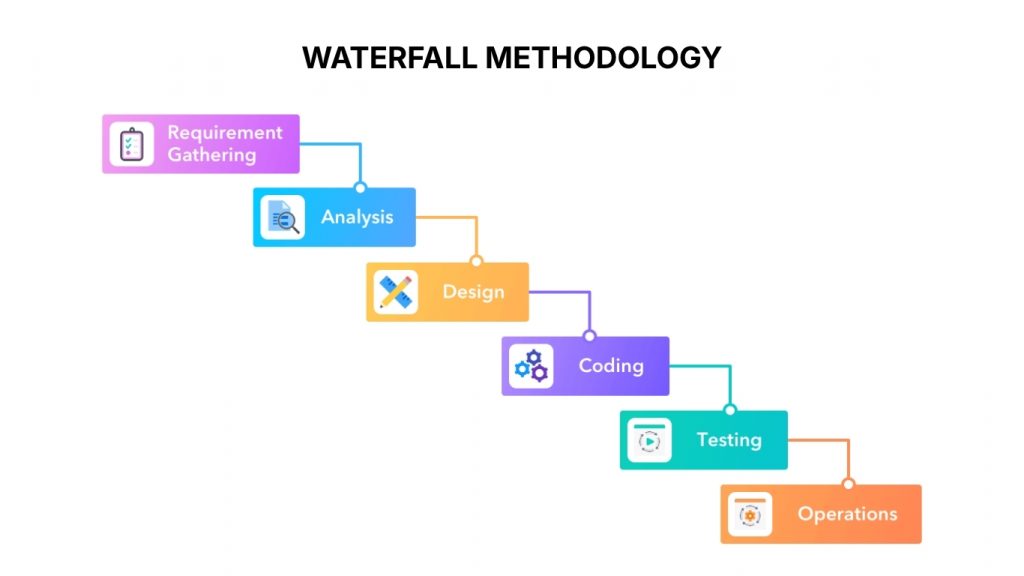
3. Rapid Application Development (RAD) Methodology
The Rapid Application Development (RAD) model, introduced in 1991, is one of the earliest iterative frameworks and remains a cornerstone of modern fast-paced development. Its core focus is accelerating delivery while maintaining high quality. Instead of following a rigid, linear process, RAD relies on rapid prototyping and continuous customer feedback to refine the product.
RAD operates through four main phases:
- Requirements planning
- Prototyping
- Testing and refinement
- Implementation
In this model, developers quickly transform requirements into functional prototypes and review them with the customer through multiple iterations. Each cycle gathers valuable feedback, helping teams detect issues early and reduce overall product risk. RAD often incorporates automation, low-code tools, and reusable components to compress timelines without sacrificing performance.
Advantages:
- Constant customer involvement helps catch problems early and reduces project risks.
- Regular iterations ensure the final product matches user expectations more closely.
- Great for small to medium projects where requirements change often.
- Faster development cycles help bring the product to market quickly.
Disadvantages:
- Requires customers to be very active and available for frequent feedback.
- It can be more expensive because it relies heavily on prototypes and specific tools.
- Limited documentation can make long-term maintenance and project oversight more difficult.
Suitable For:
RAD is ideal when you have an experienced development team and a customer committed to active collaboration. It is particularly effective when supported by low-code/no-code platforms or automation tools that accelerate prototyping and testing cycles.
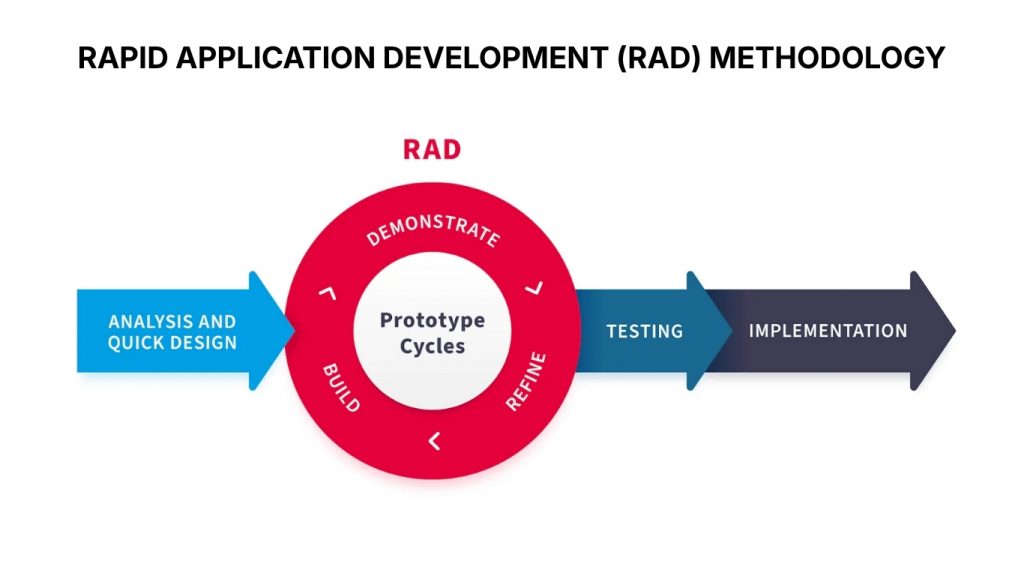
4. Scrum Software Development Methodology
Scrum is one of the most adaptable software development methodologies today. Built on Agile principles, it emphasizes iterative progress, rapid feedback, and continuous improvement. The framework revolves around three core roles: the Product Owner, Scrum Master, and Development Team. The Product Owner represents the client’s vision, prioritizing features and ensuring the team focuses on what brings the most value. The Scrum Master acts as the team’s facilitator, helping remove obstacles and ensuring proper understanding of Scrum practices. Meanwhile, the Development Team takes responsibility for planning, building, and delivering increments of the product.
Projects in Scrum move forward through short, focused sprints, typically lasting 1–4 weeks. These rapid cycles enable teams to detect issues early, test frequently, incorporate user feedback, and quickly adapt to changing requirements that making Scrum ideal for fast-paced, evolving environments.
Advantages:
- Short sprint cycles allow teams to spot issues early and fix them quickly.
- Extremely flexible and easy to adjust, thanks to continuous feedback.
- Cost-effective and well-suited for fast-moving, constantly changing projects.
- Frequent check-ins help keep everyone aligned and working toward the same goals.
- Encourages individual ownership, which boosts motivation and accountability.
Disadvantages:
- Requires a highly skilled and fully dedicated team to run smoothly.
- Daily meetings can become tiring and may lead to burnout if overdone.
- Without strong planning, rapid iterations can slow down overall delivery.
- Not ideal for very large or complex projects that depend on heavy documentation or cross-team coordination.
Suitable For:
Scrum is best for projects with uncertain or frequently evolving requirements, such as building an MVP that needs rapid testing and iteration based on user feedback. However, it is most effective when the team is experienced, self-managing, and fully committed to the Scrum process.

5. Prototyping Methodology
The prototyping model focuses on building an early, simplified version of the final product instead of developing the complete software right away. This prototyping is shared with customers for testing, evaluation, and feedback, giving them a tangible preview of how the system will work. Based on the insights collected, the prototype is refined through multiple iterations until it meets the customer’s expectations. This early validation process helps identify gaps, usability issues, and unclear requirements long before full-scale development begins, which significantly reduces project risk.
The effectiveness of this methodology depends heavily on continuous collaboration between the development team and the customer. Strong communication ensures accurate feedback and smoother iterations. It’s also important to note that the development team often absorbs the cost of creating these prototypes.
Advantages:
- Helps identify problems early, reducing the risk of major issues later in development.
- Ensures clients are on the same page before full development begins, improving satisfaction.
- Strengthens communication between the client and development team.
- Provides valuable insights that help shape the final product more accurately.
Disadvantages:
- Too many prototype revisions can slow down the project timeline.
- Clients may misunderstand the prototype and expect features that weren’t originally planned.
- Costs may rise because building multiple prototypes often requires extra time and resources.
Suitable For:
The prototyping methodology works best for projects with unclear or evolving requirements, especially platforms with complex user interactions. It helps validate assumptions early, reduce risks, and ensure the final product is built on proven concepts.

6. DevOps Methodology
DevOps is a collaborative software development approach that integrates IT operations and development teams throughout the entire product lifecycle, from design to release. It emphasizes continuous integration, testing, and deployment, enabling teams to deliver high-quality software faster while maintaining operational stability. DevOps fosters automation, close collaboration, and rapid feedback loops, ensuring that software updates and improvements are delivered efficiently.
Advantages:
- Supports continuous delivery, allowing teams to release updates and improvements regularly.
- Speeds up software deployment by fostering strong collaboration between development and operations teams.
- Enhances system reliability through automated testing, monitoring, and integration.
Disadvantages:
- Cloud-based DevOps setups may face compatibility issues across different tools and environments.
- Requires significant cultural and process changes, which can be challenging for traditional teams.
Suitable For:
DevOps is ideal for organizations seeking faster release cycles, continuous integration, and close collaboration between development and operations teams. It works best for dynamic projects requiring frequent updates and iterative improvements.

7. Behaviour-Driven Development (BDD) Methodology
Behavior-Driven Development (BDD) is an enhanced variation of the Agile methodology that emphasizes understanding and defining the expected behavior of a system from a user-centric perspective. What makes BDD stand out is its ability to create a shared vision between technical and non-technical stakeholders by using natural-language descriptions to outline how the software should perform. Its primary goal is to ensure that developers, testers, business analysts, and clients all share the same understanding of the product’s features and requirements.
BDD development revolves around behavioral scenarios written in the Given–When–Then format, typically using the Gherkin language. These scenarios act as both executable test cases and living documentation, allowing the system’s behavior to be validated continuously as development progresses.
Advantages:
- Strengthens collaboration among developers, testers, and stakeholders by keeping everyone aligned on behavior expectations.
- Ensures requirements are clear, user-focused, and easy to understand.
- Written scenarios act as both automated tests and up-to-date documentation.
- Helps the final product match real user behavior and business needs more accurately.
Disadvantages:
- Creating and maintaining detailed scenarios can be time-consuming.
- Not ideal for very large, long-term projects due to the high effort required.
- Requires ongoing participation from stakeholders to stay effective.
- Teams need proper training to write good scenarios and apply the methodology correctly.
Suitable For:
Behaviour-Driven Development is ideal for projects where close collaboration between technical teams and non-technical stakeholders is essential. It works best for applications with clearly defined user interactions or frequent requirement changes, ensuring the software aligns with real user needs. BDD is especially useful for small to medium-sized projects where automated testing and documentation are priorities.

8. Lean Development Methodology
Lean development is inspired by Toyota’s famous lean manufacturing principles, focusing on eliminating waste and maximizing productivity throughout the software lifecycle. Instead of engaging in non-essential activities, development teams concentrate on delivering high-value features while maintaining consistent product quality.
A key aspect of this methodology is its emphasis on continuous learning and deferring decisions until teams have enough information to choose the most effective solution. This mindset encourages flexibility, open thinking, and better long-term outcomes. Lean development also pushes teams to proactively identify bottlenecks that could slow progress, to create a smooth, efficient workflow. Human respect is another core principle. Lean promotes open communication and empowers team members to contribute ideas, fostering stronger collaboration and higher motivation.
Advantages:
- Eliminates wasteful activities such as unnecessary code, excessive documentation, and repetitive tasks.
- Reduces development costs by optimizing time, resources, and workflow.
- Increases overall efficiency, helping teams deliver products faster.
- Boosts team motivation by giving developers more ownership and autonomy in decision-making.
Disadvantages:
- Works best with highly skilled, disciplined developers who can self-manage effectively.
- Team members with less experience may feel overwhelmed by the high level of independence required.
- Although it focuses on removing waste, Lean still requires strong documentation standards, which can add pressure to analysts and planners.
Suitable For:
Lean development works best for small, skilled teams where efficiency, rapid iteration, and reduced waste are top priorities. It becomes less practical for large-scale projects, which often require extensive coordination, more documentation, and larger teams to manage the workload effectively.
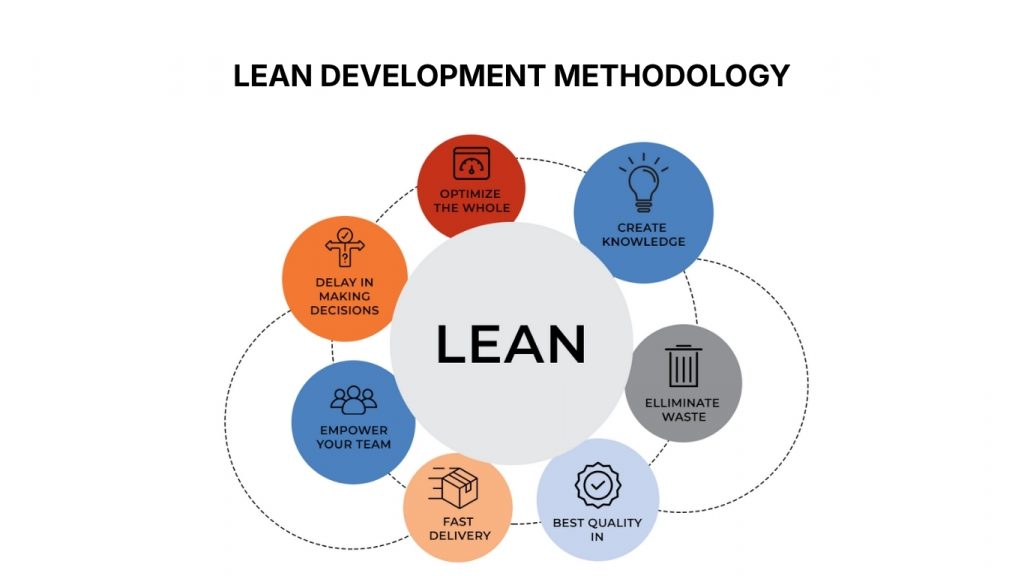
9. Feature Driven Development (FDD) Methodology
Feature-Driven Development (FDD) is an Agile-based software development methodology designed to reduce confusion, avoid costly rework, and keep large teams aligned. While the name may suggest a focus on individual product features, FDD actually centers on building a detailed, feature-oriented model of the entire system. In this methodology, the project is broken down into a comprehensive feature list. Each feature then goes through a short, structured cycle of planning, design, and development, typically lasting no more than two weeks. This iterative approach ensures that progress is measurable and that the team delivers consistent, meaningful output throughout the project lifecycle.
FDD is especially effective for large-scale projects, as it relies on strong documentation, clear standards, and well-defined roles, which allow multiple teams to work in parallel without losing cohesion.
Advantages:
- Breaks big, complex projects into smaller feature-based tasks, making development easier and more organized.
- Allows large teams to work in parallel on different features, speeding up delivery.
- Uses well-defined standards and processes, helping ensure consistency and predictable outcomes.
Disadvantages:
- Depends heavily on a strong lead developer to coordinate the team and keep all feature work aligned.
- If not managed carefully, the team may focus too much on completing tasks rather than delivering real user value
Suitable For:
Feature-Driven Development is best suited for large teams handling complex, enterprise-level projects. It combines the flexibility of Agile with the clarity and structure needed for high-scale development, provided an experienced lead developer is in place to guide the process.

10. Extreme Programming (XP) Methodology
Extreme Programming (XP) is an Agile-based methodology designed to deliver fully functional software quickly, even in complex and rapidly changing environments. XP emphasizes continuous feedback, iterative development, and close collaboration between developers and stakeholders, making it particularly effective for projects with tight deadlines or evolving requirements. Key practices include pair programming, test-driven development, and frequent releases to ensure software quality and adaptability.
Advantages:
- Cost-effective and suitable for both small and large teams.
- Enhances risk management, increasing the likelihood of project success.
Disadvantages:
- Requires frequent reviews and stakeholder meetings, which can be time-consuming.
Suitable For:
XP works best for projects in unstable or fast-changing environments where requirements evolve frequently. It is ideal for small to medium teams that can commit to continuous communication and iterative development cycles.
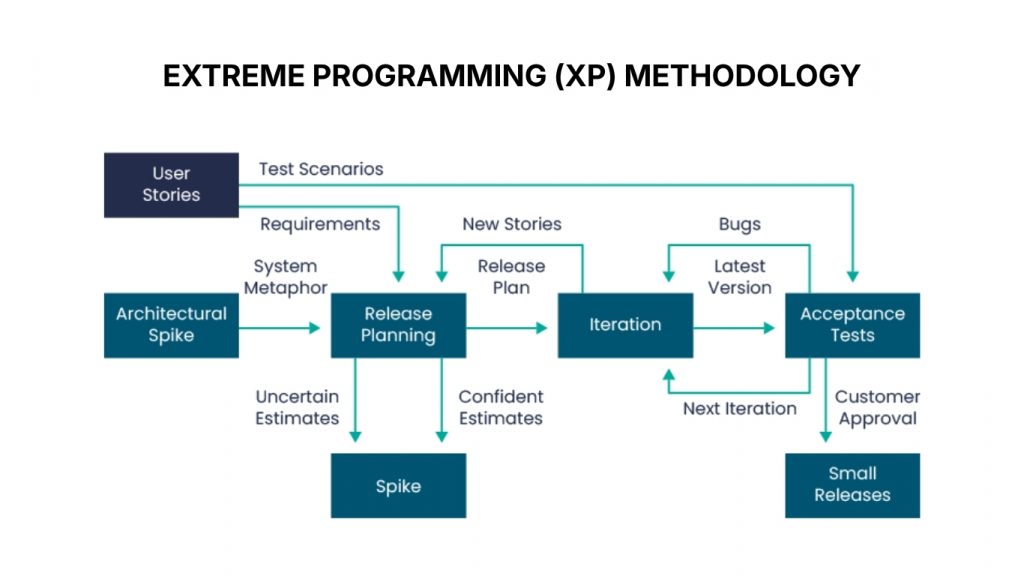
11. Spiral Methodology
The Spiral methodology is a sophisticated software development lifecycle model that emphasizes early risk identification and mitigation. It combines iterative development with systematic risk analysis, allowing developers to make necessary changes to design or code during the testing stage. This approach ensures flexibility, continuous improvement, and a higher probability of project success, particularly for large, complex projects.
Advantages:
- In-depth risk analysis helps identify and prevent major issues early in the development process.
- Offers high flexibility, allowing important changes to be made even during the later testing stages.
- Well-suited for projects where safety, reliability, or compliance is a top priority.
Disadvantages:
- Requires significant time, budget, and resources, making it inefficient for simpler or low-risk projects.
Suitable For:
The Spiral methodology is ideal for large-scale, high-risk projects where flexibility, risk management, and iterative refinement are essential. It is less suitable for small, straightforward projects due to its complexity and resource requirements.
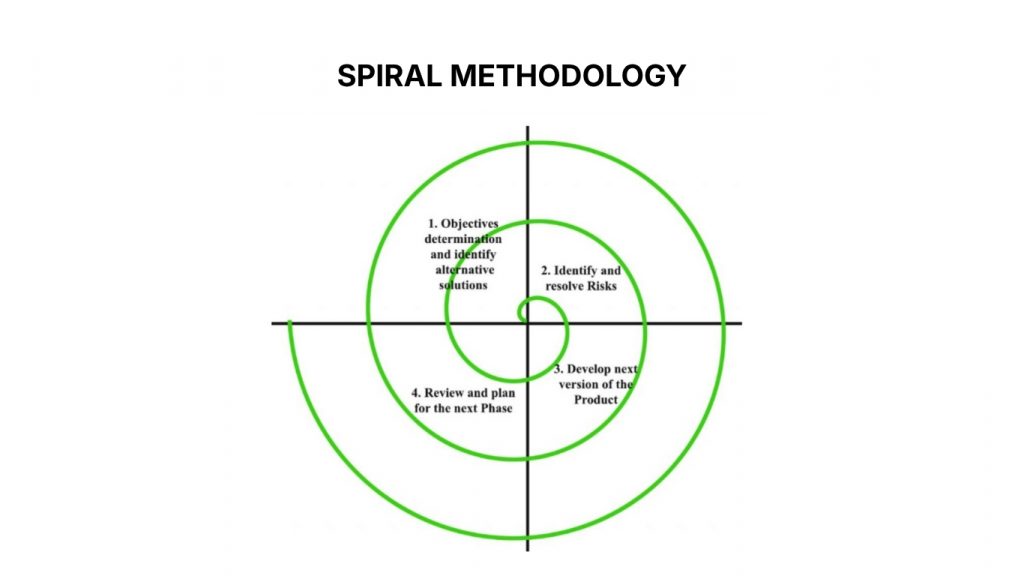
12. Rational Unified Process Methodology
The Rational Unified Process (RUP) is a highly structured software development methodology designed to handle complex requirements and large-scale projects. Unlike more flexible Agile frameworks, RUP follows a disciplined, phase-driven model that emphasizes documentation, architectural clarity, and systematic progress.
The framework divides development into four well-defined phases:
- Inception
- Elaboration
- Construction
- Transition
This structured approach ensures every stage is carefully planned, monitored, and documented, making RUP especially valuable for projects involving multiple stakeholders, strict regulations, or high technical complexity.
Advantages:
- Spots and fixes risks early with step-by-step development.
- Strong architecture makes software high-quality and easy to maintain.
- Clear milestones and workflows help plan time and budget accurately.
- Good documentation keeps everything transparent and easy to track
Disadvantages:
- It can be expensive and needs lots of resources, not ideal for small teams.
- Heavy structure can feel too rigid for simple projects.
- Less flexible than Agile, so big changes can be slower to handle.
Suitable For:
RUP is ideal for large, complex, enterprise-level projects requiring predictability, rigorous documentation, and strong architectural governance. It is also suitable for startups building mission-critical or compliance-heavy systems where structured processes help minimize risks and ensure long-term stability.
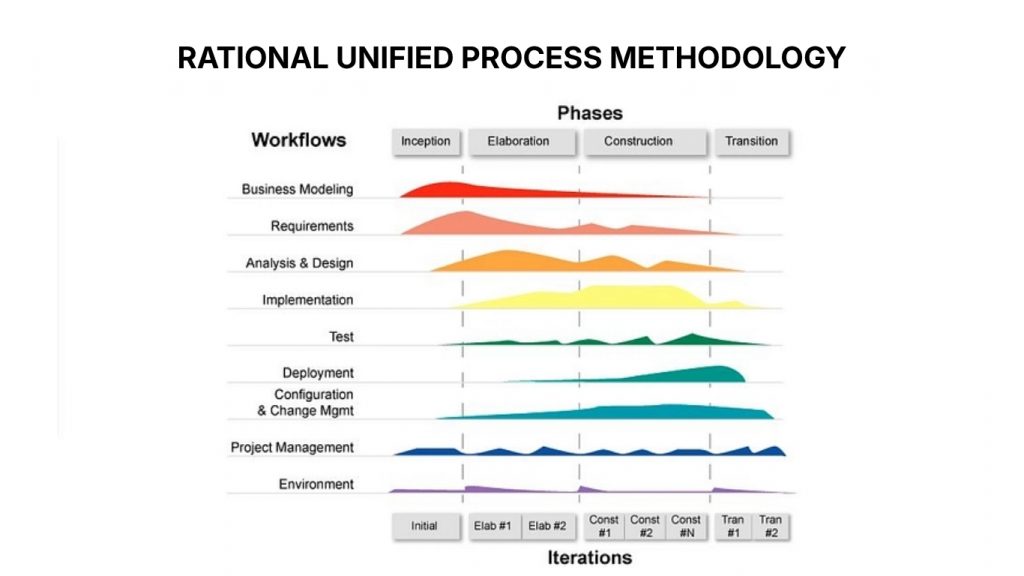
13. Adaptive Software Development Methodology
Adaptive Software Development (ASD) software development methodology is all about flexibility and learning through an iterative cycle of speculation, collaboration, and learning.
These three are the pillars of this methodology and make it thrive in environments of uncertainty and rapid change. That’s why ASD methodology is a suitable choice for startups aiming to innovate quickly. Unlike traditional methodologies that rely heavily on strict planning and control, ASD is all about adapting to evolving requirements in real-time.
Advantages:
- Fast iterations and adaptability allow quicker releases, helping startups react to market needs.
- Supports experimentation and learning, perfect for testing new ideas.
- Continuous feedback ensures the product meets real user needs.
Disadvantages:
- Informal processes can make scaling larger projects harder.
- Needs a skilled, collaborative team that can work independently.
- Focusing on change may lead to less documentation, making future maintenance harder.
Suitable For:
As we mentioned above, ASD is the best option for startups working in dynamic industries where requirements are expected to change frequently, such as tech innovators or companies operating in rapidly evolving sectors.
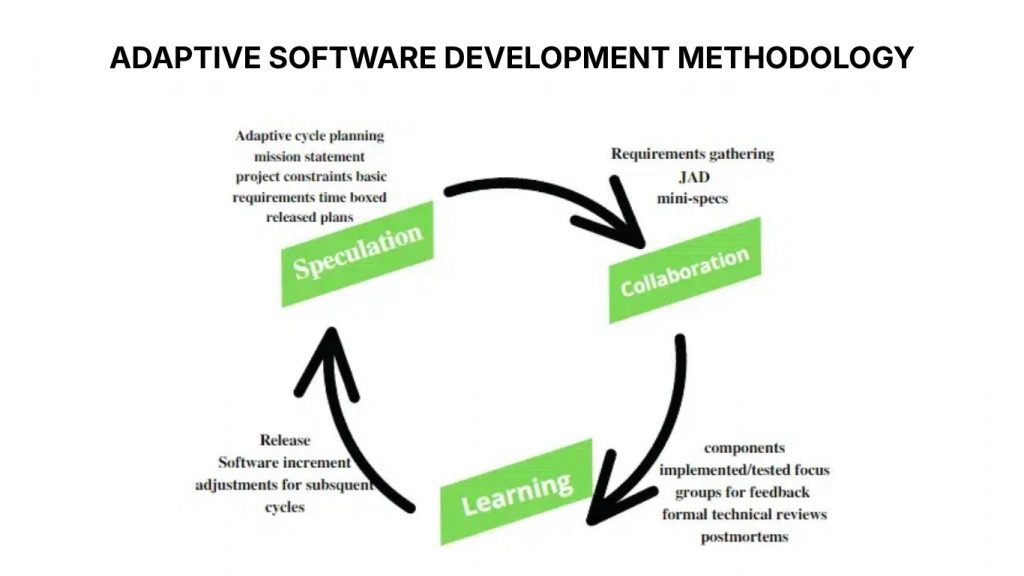
14. Dynamic Systems Development Model Methodology
The Dynamic System Model (DSM) builds on the principles of Rapid Application Development, offering a more structured and business-aligned approach to fast software delivery. This methodology focuses on ensuring that development outputs closely match real business needs, following four iterative phases: feasibility and business study, functional modeling, design and build, and implementation.
A defining characteristic of DSM is its high level of end-user involvement. Continuous feedback throughout each phase helps minimize misunderstandings, reduce risks, and keep the project aligned with core objectives. Unlike many Agile frameworks, DSM also emphasizes comprehensive documentation, supporting clarity, governance, and long-term maintainability.
Advantages:
- Iterative cycles help deliver key features quickly.
- Strong control over timelines and budgets.
- Detailed documentation at every stage.
- Close collaboration with users keeps the project aligned with goals.
Disadvantages:
- It can be expensive due to high user involvement and coordination needs.
- Not ideal for small teams with limited resources.
- Conceptually complex, which can be hard for inexperienced teams to adopt.
Suitable For:
The Dynamic System Model is best suited for large enterprises dealing with bureaucratic processes, siloed teams, and high compliance requirements. Its structured yet iterative nature helps break down rigid workflows, streamline communication, and accelerate delivery while maintaining strong governance.
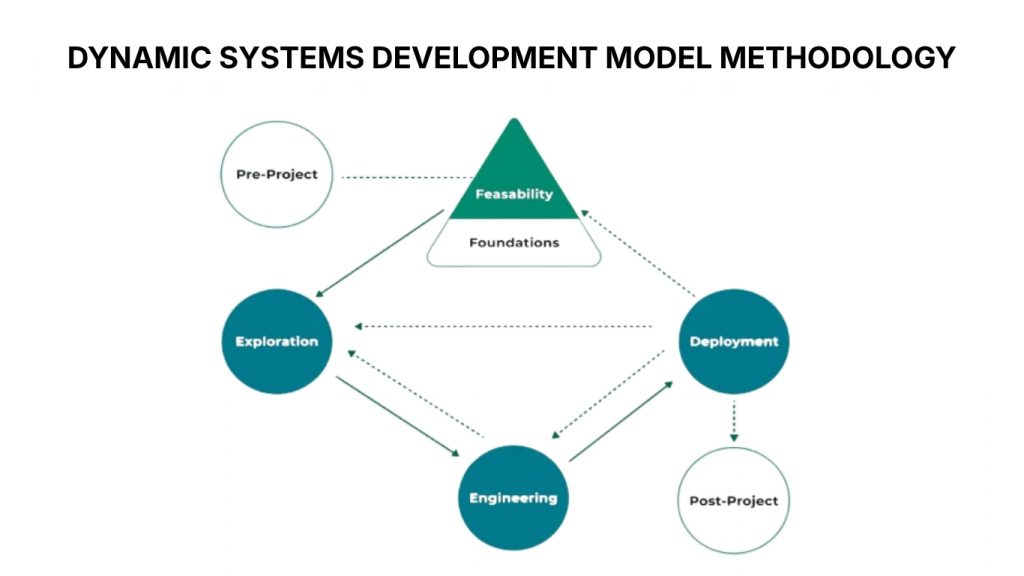
15. Joint Application Development Methodology
Joint Application Development (JAD) is a collaborative software development approach that emphasizes active user involvement during the design and development phases. It relies on interactive workshops where developers, stakeholders, and end-users work together to define requirements, resolve issues, and refine solutions. This methodology ensures that software aligns closely with business needs and user expectations.
Advantages:
- Produces high-quality, low-error software.
- Promotes valuable insights through direct developer-user collaboration.
Disadvantages:
- It can be time-consuming because of workshops and stakeholder involvement.
Suitable For:
JAD is ideal for projects where clear communication between end-users and developers is critical, especially in business software solutions that require precise requirements and rapid consensus.
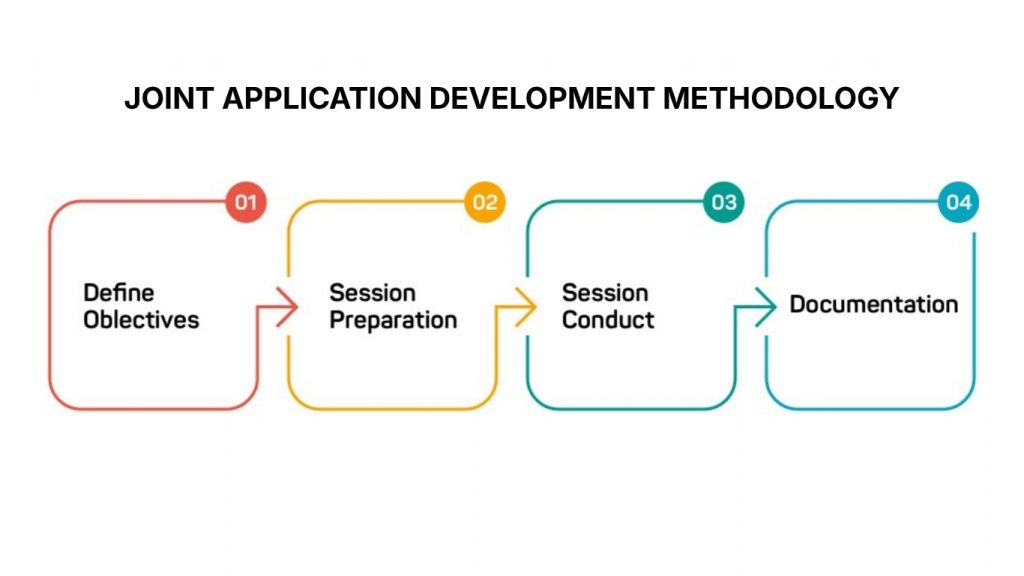
How to Choose the Right Software Development Methodology
Choosing the right software development methodology is critical, as it influences project management, product quality, timelines, and costs. Businesses need to assess key factors to ensure the methodology aligns with the project’s unique requirements and constraints.
1. Project size and Complexity
The size and complexity of a project determine the most suitable methodology. Large-scale projects with multiple components often benefit from structured approaches like the Waterfall, which ensure each phase is completed sequentially. Smaller or fast-changing projects are better suited for flexible methods like Agile, which allow iterative development and frequent adjustments based on feedback.
2. Risk level and Mitigation strategies
High-risk projects, especially those involving new technologies or uncertain requirements, need methodologies emphasizing testing and feedback, such as Agile or DevOps. These approaches help identify issues early and reduce project risk. Low-risk projects with clearly defined requirements may be efficiently managed using traditional methodologies like Waterfall, offering predictability and control.
3. Timeframe and Budget constraints
Projects with tight deadlines or limited budgets require efficient resource allocation. Agile delivers features in short cycles, allowing teams to prioritize critical functionalities while maintaining flexibility. Waterfall, with its detailed upfront planning, is useful for projects with fixed budgets and timelines, providing a predictable cost structure.
4. Team expertise and Collaboration style
The development team’s skills and preferred workflow play a major role. Teams experienced in Agile or DevOps excel in iterative, collaborative environments, handling rapid changes and continuous integration effectively. Teams accustomed to structured, linear processes may find the Waterfall model more suitable, ensuring clear roles and responsibilities.
5. Industry regulations and Security requirements
For industries like healthcare, finance, or government, compliance and security are critical. Methodologies that support thorough documentation and regulatory adherence, like Waterfall, are often preferred. Agile can also be adapted for these sectors, provided proper security protocols and documentation practices are in place.
6. Long-term maintenance and Scalability
Scalability and ongoing maintenance are essential for long-term project success. Agile methodologies, with iterative updates and continuous feedback, are highly adaptable for evolving requirements. Projects expecting frequent changes or growth should adopt methodologies that support regular improvements, ensuring the software can scale with business needs.
Benefits of Using the Right Methodology
Choosing the right software development methodology can have a significant impact on the success of a project, which brings several advantages:
- Improved project management: Clear processes help teams stay on track and meet deadlines.
- Higher quality software: Methodologies like Agile, Lean, and Scrum emphasize testing and feedback, reducing bugs and errors.
- Cost efficiency: Avoid wasted resources by following a process aligned with project scope and requirements.
- Better collaboration: Iterative methodologies promote communication between developers, stakeholders, and end-users.
- Faster delivery: Structured approaches streamline development, helping teams release functional software quickly.
FAQs About Software Development Methodologies
What is Kanban software development methodology?
Kanban is a visual workflow management method that helps teams track tasks using boards and cards. It emphasizes continuous delivery, efficiency, and limiting work in progress to avoid bottlenecks. Kanban is ideal for projects with changing priorities and a need for ongoing optimization.
How does Agile differ from Waterfall?
Agile is iterative and flexible, focusing on customer feedback and incremental delivery. Waterfall is linear, with distinct phases like requirements, design, development, and testing. Agile adapts to change quickly, while Waterfall works best for projects with clearly defined requirements.
What is the best software development methodology?
There’s no one-size-fits-all answer. The “best” methodology depends on project goals, complexity, team size, and stakeholder involvement. Agile, Scrum, and Lean are widely popular for dynamic projects, while Waterfall and RUP are preferred for structured, large-scale projects.
What are the best software development methodologies for small projects?
For small projects, Agile, Scrum, and RAD are ideal due to their iterative nature, faster time-to-market, and flexibility. Lean and Kanban can also work well for teams looking to optimize efficiency and reduce waste without the overhead of complex processes.
A Software Development Methodology is a fundamental framework that guides how software teams plan, build, and deliver products. By following a structured methodology, teams can streamline workflows, reduce errors, and improve overall product stability. Each methodology comes with its own advantages and limitations, which means there’s no one-size-fits-all approach. In many cases, combining multiple methodologies or adapting them to fit the project context can create a more efficient, flexible, and secure development process. Ultimately, applying software development methodology effectively helps development teams boost productivity, minimize defects, and deliver high-quality software that meets user expectations.
For businesses looking to implement the most suitable software development methodology with expert guidance, TopOnTech (TOT) offers comprehensive solutions tailored to your project needs. TOT is a pioneer in the digital transformation journey. We deliver website design, mobile app development, and custom software solutions with flexible services tailored to each business’s exact needs.
Inspired by the philosophy of “Technology for People,” TOT empowers businesses to operate more efficiently, elevate customer experiences, and build a lasting brand impression.
TOT is a pioneer in the digital transformation journey. We deliver website design, mobile app development, and custom software solutions with flexible services tailored to each business’s exact needs.
Inspired by the philosophy of “Technology for People,” TOT empowers businesses to operate more efficiently, elevate customer experiences, and build a lasting brand impression.
TopOnTech (TOT) Contact Information:
🌐 Website: https://topon.tech/en/
📞 Hotline/WhatsApp/Zalo: (+84) 906 712 137
✉️ Email: long.bui@toponseek.com
🏢 Address: 31 Hoang Dieu Street, Ward 12, District 4, Ho Chi Minh City, Vietnam
